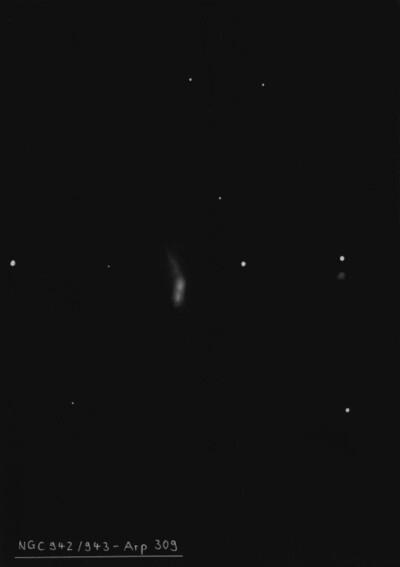
Frank Muller discovered NGC 942 = LM 1-53, along with NGC 943, in 1886 with the 26" refractor at Leander McCormick Observatory. He described both as a "nebulous double star?" His rough position is a close match with MCG -02-07-018 = PGC 9458, the southeastern member of the pair. Herbert Howe measured accurate positions for the pair in 1897 using the 20" refractor at Chamberlin Observatory as well as Sherburne Burnham (Publ of Lick Observatory, II).
In March 2020 Yann Pothier found the original discovery of NGC 942 and 943 was made by LdR assistant Ralph Copeland on 31 Jul 1872. He recorded "Double in position 159.0°, distance of nuclei = 40".4; both are R; psbM but the np is slightly larger than the other. Position of a 12m * from the brighter of the nebulae = 286.4°, distance = 139.3". But Copeland assumed he was observing NGC 945, discovered by William Herschel, and furthermore provided no coordinates or reference for Dreyer to compute a position.
400/500mm - 17.5" (12/4/93): this is the slightly brighter southern member of a double system with NGC 943. Appears faint, very small, round. Increases to a small brighter core and faint stellar nucleus. NGC 943 is just 30" N and both galaxies appear immersed in a common halo. NGC 950 lies 12' S.
600/800mm - 24" (12/22/14): NGC 942 is the slightly brighter and southern component of a close double system with NGC 943. At 375x it appeared moderately bright, small, slightly elongated, 0.4'x0.3'. Well concentrated with a very small, very bright core and stellar nucleus. NGC 943 is just 30" SSE (between centers) and within a common halo.
IC 230 (discovered by S.W. Burnham in 1891) lies 5.5' due west and appeared faint to fairly faint, small, round, 12"-15" diameter. Easily seen despite a mag 15.7B.
Notes by Steve Gottlieb